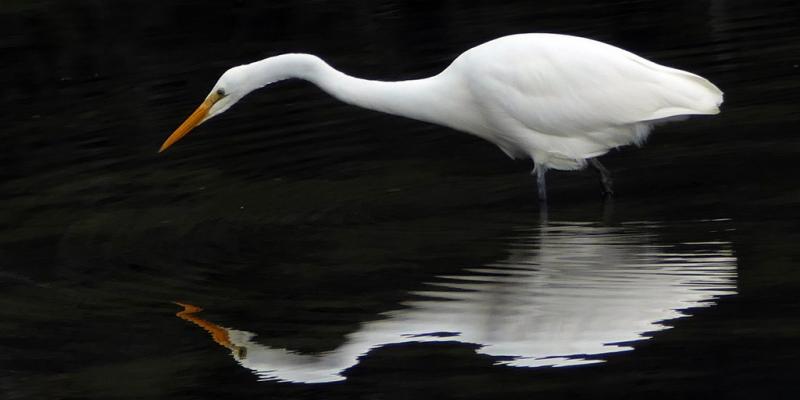White Heron
Common Name White Heron
Maori Name Kotuku
Scientific Name Egretta alba modesta
The white heron, or great egret, is found worldwide in tropical and temperature regions. One of four or more subspecie, Egretta alba modesta can be found in China, India, Japan, Australia and New Zealand.
New Zealand is near the extreme limit of its range both geographically and climatically. The only breeding site in this country, on the banks of the Waitangituna Stream at Okarito in South Westland, was discovered in 1865. Owing to its breeding feathers being in high demand as ornaments, and possibly because of fluctuations in breeding conditions, by 1941 there were only 4 nests at Okarito. Declared a Reserve and patrolled at breeding times, today the number of nests appears stable with a permanent population of between 100 and 120.
The continued survival of white herons has been one of the major successes of the early stages of wildlife conservation in New Zealand. Had they been an endemic bird no doubt years ago they would have been on the “critically endangered” list.
Numbers
Between 1 and 4 White Heron spend some time, usually autumn and winter in Christchurch waterways and wetlands.
Spread
- Geographically and climatically New Zealand is near the extreme limits of their range.
Description
- Stately and elegant
- Prefer to feed alone
- Adapted for wading in shallow, muddy waterways
- Long legs bare of feathers to above the ankle join
- Long spreading toes
- Long slender neck
- Yellow bill
- Thin legs
- 92 cm in length
- 900 grams in weight
- In flight the neck is kinked
- Typically heron croak in flight or if disturbed
- Live up to 22 years
Habits
- Stalk fish, eels and insects in shallow water
- Feeds mostly on small fish (whitebait) frogs, shrimp, mice and small birds (silvereyes)
- Grab prey with sharp dagger-like beak
Habitats
- Seen on stream banks, pond edge, wet grassland, and estuarine mudflats
- After breeding birds disperse widely throughout the country
History
- Always been rare in New Zealand
- Attained almost mythical statues
- Revered by Maori and European for white feathers
- Believed colony formed by natural introduction from Australia hundreds of years ago (occasional visitor still blown across)
- First steps to protect these birds taken in 1924 when 60 metre strip on either side of the Waitangiroto River declared as sanctuary from logging.
- Since observations began in 1944 numbers of recorded nest reached as high as 65 with 60 fledglings in 1981.
- Since 1982 the number of nests remain about 40 -50
Breeding
- In New Zealand only breeds in South Island near Whataroa, South Westland
- Breeds between September and January
- Arrive August/September
- Females build actual nest platform
- Nest in kamahi, mahoe and kowhai trees and in crowns of tree ferns (3 to 13 metres above ground)
- Females lay 3 to 5 pale blue/green eggs September/October
- Both sexes share incubation
- Chicks are feed by both parents and fledge at about 42 days
- Leave colony 3 weeks later
- During breeding feeds in costal lagoons, particularly nearby Okarito Lagoon.
- During breeding bills darken, veil of fine feathers extend beyond the folded wings and tail
- Elaborate courtship displays:
Males build small platforms from which they advertise to females
Displays include spectacular raising of nuptial plums, neck erect, bill snapping, wing feathers flicking
- Once the female is attracted they preen each other intertwine long necks, bills and wings
- Breeding site at Waitangiroto discovered in 1865
- 1941 this breeding site was down to just 4 nests
- 1957 colony gazetted as a wildlife refuge and became Waitangiroto Nature Reserve in 1976
- 1976 declared a Reserve and Wildlife Refuge and patrolled at breeding time.
- Now nests are left virtually undisturbed
- Permanent population 100 to 120 birds and appears stable
Comment
- So seldom does Kotuku appear in any locality that “rare as Kotuku” has passed into a proverb amongst Maori.
- On the 10 June 2008 park rangers, teachers and a group of students from Harewood School were the first to observe a white heron in the Styx Mill Conservation Reserve, where it was roosting in the willow trees and feeding on bullies and other small fish in the lakes. This bird is the first recorded sighting of white heron at Styx Mill Conservation Reserve making it the 49th specie to be seen at this location.
- White heron can be attracted to the area by naturalising streamside habitats and minimising disturbance from humans and dogs


